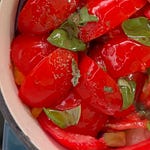Let’s be honest: if there were a culinary equivalent of a loyal dog—faithful, generous, and always glad to see you—it would be the chickpea. Modest in size but mighty in character, this ancient legume has been feeding civilizations since the Bronze Age. And unlike fleeting food trends and overpriced superfoods, the chickpea has never needed to rebrand itself. It has always been here, doing its job with quiet brilliance.
The chickpea is no newcomer to our plates. Archaeologists have found evidence of its cultivation in the Middle East over 7,000 years ago. From Roman feasts to North African stews, it’s been a trusted source of sustenance across empires and continents. You’ll find it lovingly cooked in the kitchens of Lebanon, Morocco, Italy, India, and yes—especially—in the warm, sun-soaked towns of southern France.
In Provence, it’s not just a pantry staple; it’s practically part of the DNA.
The beauty of the chickpea lies in its democratic nature: cheap, easy to find, endlessly versatile, and full of flavor. It plays well with spices and sauces, turns into silky purées, crisps up beautifully when roasted, and somehow manages to appear in everything from street food to haute cuisine without losing its charm.
You want snacks? Roasted chickpeas, crunchy and spiced.
Starters? Hummus, falafel, panisse—pick your regional hero.
Main courses? Chickpea curry, tagine, or a rustic Provençal stew.
Dessert? Chickpea flour pudding, sweetened with orange blossom and almonds.
There’s even aquafaba—the liquid from cooked chickpeas—which can be whipped into meringue, mousse, or vegan mayonnaise. It’s absurd, really, how useful one little legume can be.
In the South of France and across the Mediterranean basin, chickpeas aren’t just food—they’re culture. They represent abundance, frugality, and warmth. Rich in fiber and protein, chickpeas keep you full without weighing you down. They’re naturally low in fat, rich in complex carbs, and packed with micronutrients like folate, iron, and magnesium.
You’ll rarely find obesity epidemics in regions where chickpeas are part of the daily diet. No one ever got fat eating too much chickpea salad and I also have to confess that in my house, we never did French fries. My mother—Provençal to her core—would frown at the thought of deep-frying potatoes. To her, the only “fries” worth making were panisse: golden batons of creamy chickpea dough, sliced and seared in olive oil until the edges crisped up, and the center stayed soft and almost custardy. Comfort food in its purest form. Panisse is the soul of the Mediterranean kitchen. Hot from the skillet, sprinkled with sea salt, maybe a dash of black pepper or a squeeze of lemon—that’s all it needs. Whether eaten as an afternoon snack, a casual starter with a glass of rosé, or even as dinner when no one feels like cooking, panisse is both humble and magical.
So in a time when ultra-processed foods dominate supermarket aisles and protein comes with a marketing team, the chickpea quietly offers everything we need. It fills you up, fuels your body, supports your health, and connects you to a long line of people who knew how to eat well without overdoing it.
It’s time for a chickpea renaissance. Let it rise beyond the confines of hummus. Let it stand proudly beside pasta, meat, or nothing at all. Let it be roasted, stewed, fried, or sweetened. Let panisse be the new French fry. You’ll never miss the potato.
Classic Panisse (Chickpea Fries)
Ingredients:
250 g (about 2 cups) chickpea flour (also called farine de pois chiches)
1 liter (4 cups) water
2 tbsp olive oil (plus extra for frying)
1 tsp salt
Freshly ground black pepper (optional)
Instructions:
Prepare the panisse mixture:
In a heavy-bottomed saucepan, bring the water, olive oil, and salt to a simmer.
Gradually whisk in the chickpea flour to avoid lumps.
Keep whisking constantly over medium-low heat for about 10–15 minutes, until the mixture thickens and becomes smooth and glossy (like thick polenta). It should pull away from the sides of the pan.
Chill the dough, cut and fry
Pour the mixture into a greased or parchment-lined rectangular dish or baking sheet (about 1 to 1.5 inches thick).
Smooth the top and let it cool at room temperature, then refrigerate for at least 12 hours (or overnight) until fully set.
Cut and fry:
Once firm, cut into fries, rectangles, or wedges.
Heat a generous amount of olive oil in a nonstick or cast-iron skillet over medium-high heat.
Fry the pieces until golden and crisp on all sides, about 3–5 minutes per side.
Drain on paper towels and season with salt and pepper.
To Serve:
Serve hot, with m ore black pepper (yes black pepper is chickpea best partner) , optionally with a tapenade dip (that is what I eat Panisses in the clip here) or just a squeeze of lemon.












Share this post